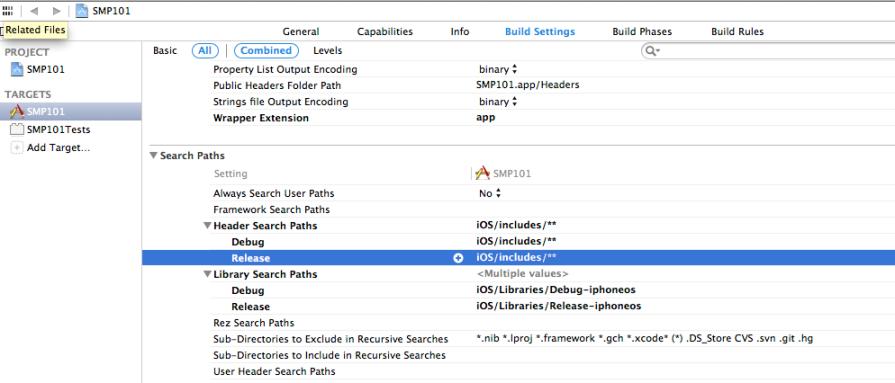Configure the build settings for the Xcode project, then build the project.
- In the Project Navigator, under Project, select
SMP101 > Build
Settings and scroll down to the Search Paths section. Enter the
location of the iPhone simulator libraries in the Header Search Paths and
Library Search Paths fields.$SRCROOT is a macro that expands to the directory where the Xcode project file resides. Adding this macro in front of the path is optional.
- In Header Search Paths, enter the path to the iOS/includes directory, then select the recursive option. In this example, the path is indicated as iOS/includes/**.
- In Library Search Paths, specify profiles for Debug and Release. In this example, the path is indicated as "iOS/Libraries/$(CONFIGURATION)$(EFFECTIVE_PLATFORM_NAME)". Escape the path names using double quotes.
- To build with 64-bit architectures, in the Project Navigator, under Target,
select SMP101 > Build Settings. Select Architectures, and scroll down to
select Standard architectures (including
64-bit)(armv7,armv7s,arm64).
- In the Project Navigator, under Target, select SMP101
> Build Settings, then expand the Apple
LLVM 5.0 Language - Objective C section.
Set Objective - C Automatic Reference Counting to No to disable automatic reference counting.
- In the Project Navigator, under Target, select
SMP101 > Build Phases, then
expand the Link Binary with Libraries
section.Click the + icon below the list, select the following libraries, and then click Add to add them to the project:
- CFNetwork.framework
- CoreFoundation.framework
- libicucore.A.dylib
- libstdc++.6.0.9.dylib
- libz.dylib
- MobileCoreServices.framework
- Security.framework
- SystemConfiguration.framework
- In the Project Navigator, under Target, select SMP101 > Build Phases, then expand the Copy Bundle Resources section. Select SMP101-info.plist and click on the - sign to remove it.
- Select Product > Clean , then Product > Build to test initial project setup. If you correctly followed this procedure, you see a Build Succeeded message.


